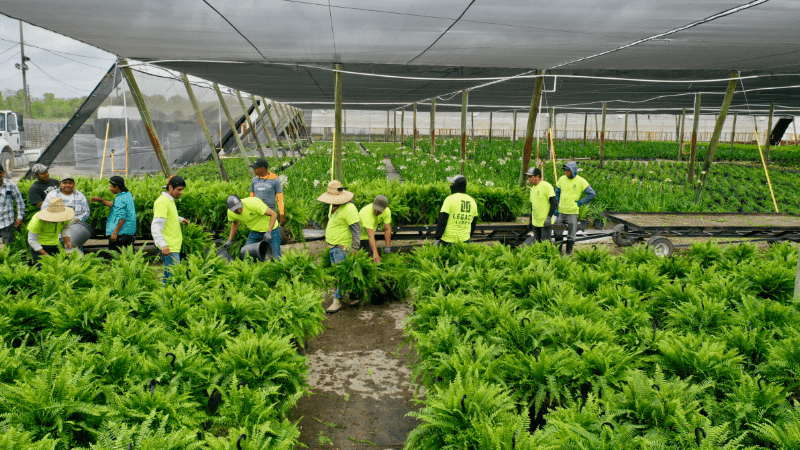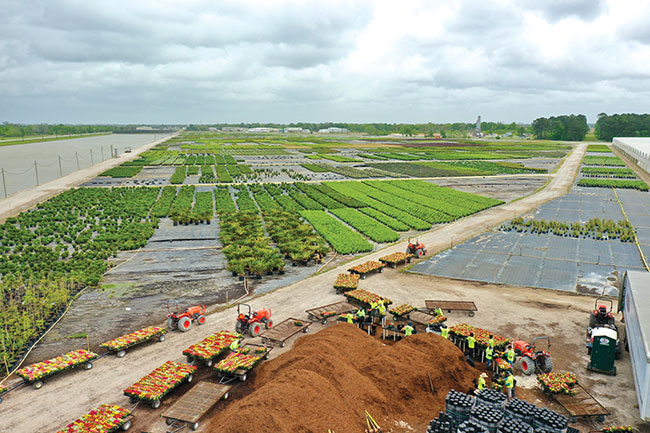
Working with a changing labor force
The U.S. has record low unemployment, currently around 3.5%, but our industry is still feeling the shortage of workers. According to the 2022 Greenhouse and Nursery Labor and Employment Survey by AmericanHort, employers are experiencing a shortage of about 20% in their workforce.
PANDEMIC PROBLEMS
Many companies really began to feel the pressure of the changes in labor once the pandemic hit full force. Justin Bartlett, co-owner and chief financial officer of Legacy Labor, says issues with the supply of labor in our country have been happening since before COVID-19 — it’s just something that the labor force has always dealt with. Our industry is filled with manual labor jobs and many of these jobs are not filled by our local workforce because of that.
“I think that it’s been like that for several years and it is slowly just getting worse and worse. And, I think, COVID coming just magnified that and spread that along faster than it was going before,” Bartlett says. Most employers are noticing the shortage of labor, whether they are in the horticultural industry or not.
More than half of the growers who reported a labor shortage in the AmericanHort survey agreed that the coronavirus made matters worse. Along with limited workers, growers say they spent $5,000 on average, per employee, on COVID-related preventions.
CONSISTENT CHALLENGES
It’s been especially hard to find reliable, consistent workers in the agriculture industry because there are many manual labor jobs that need to be filled. “The climate that they’re working in, working outdoors, working with their hands, the manual labor that is involved in our industry is just tough; it’s a tough job,” Bartlett says. Legacy Labor talks with growers all over the U.S. everyday that are in need of labor, discussing what their biggest headaches are and what their biggest needs are — consistent labor.
The pandemic quickly made the situation worse, due to travel restrictions reducing the number of foreign workers coming in to fill positions. Also, being forced to stay home and shut down operations during that time has made it hard to get back to how it was before COVID-19, he says. In 2021, only one-third of growers were able to hire all the workers they needed, according to the AmericanHort survey.
Jennifer Moss, hiring manager and CEO of Moss Greenhouses, says they are fighting the same battles as every other company in the world. “It is as if you are paying more for less just like at the grocery store. We just don’t have the bodies to do the jobs because other industries can offer more, and the work isn’t as hard,” Moss says.

FINDING LABOR
“The biggest thing we hear every day is that there are problems with labor, getting labor, reliable consistent labor — and there’s a solution out there,” Bartlett says. “If you’re not using H-2A, you haven’t thought about it, you’re going to need it in the future for sure.” The local workforce is not going to fill the large majority of jobs that growers have, and the H-2A program has grown dramatically over the last 10 years to help fill the gaps. Ten years ago, around 50,000 H-2A visas were issued compared to 317,000 visas in 2022.
Legacy Labor provides H-2A labor to companies in need, using the H-2A visa program. There are a lot of rules and regulations with the program, which keeps some employers from using it as a source of labor. It takes a lot of time to manage the paperwork and deal with rule changes and compliance with the U.S. Department of Labor (DOL). Legacy Labor recruits workers, files the paperwork to get the petition and job order approved with DOL, and makes proper arrangements to get them across the border to housing and work sites, says Bartlett.
“We handle all the workers’ compensation, the insurance, transportation — they’re essentially Legacy Labor employees. And so, all of the compliance with DOL, the exposure, is off the grower’s plate; it’s on our plate,” he says. So if DOL shows up to audit the H-2A program, the audit will be conducted on Legacy Labor and not on the grower.
“The hiring and firing, disciplinary, all the management of the workforce is on us. [Growers] can really focus on building their business, and they know that they’re going to get a consistent, reliable workforce to show up every day to work,” Bartlett says.
Although Legacy Labor hasn’t seen a shortage in finding qualified workers to fill the positions that are requested by companies, one of the biggest challenges they deal with is the time it takes to get paperwork done and housing in order. “We have a lot of growers that call us that need workers two weeks from now or next week or a month from now, and it takes typically 120 days to do the paperwork and all the filing and recruiting and getting housing inspected,” he says.
Recent changes made to H-2A rules in October 2022 have made some cause for concern. “There needs to be a reform in that for sure. We’re involved in different associations that advocate for change in the form of that space, and we’re doing everything we can as a company to help with that,” Bartlett says.
The advocacy team at AmericanHort is also focused on workforce reforms needed and helping to achieve changes within the program to reduce the costs of implementing H-2A visas.
OTHER OPTIONS
Although 35% of growers stated that they have used the H-2A visa program, according to the AmericanHort survey, half of those growers struggled to fill non-seasonal jobs that don’t currently qualify for the H-2A program. Working toward changes within a company’s operation can save time and labor.
Half of the growers surveyed by AmericanHort used new forms of automation in response to the workforce shortage. Around 40% of operations decided to change their product offerings to reduce labor costs and more than 65% reported making operational changes to help deal with the labor availability problems they were facing.
“Today’s workforce is more diverse than we have ever seen and, thus, provides many opportunities and challenges for any owner or hiring manager,” Moss says. Her main goal is to find capable individuals to do the job and show up every day.
For an enhanced reading experience, view this article in our digital edition by clicking here.









 Video Library
Video Library 


















